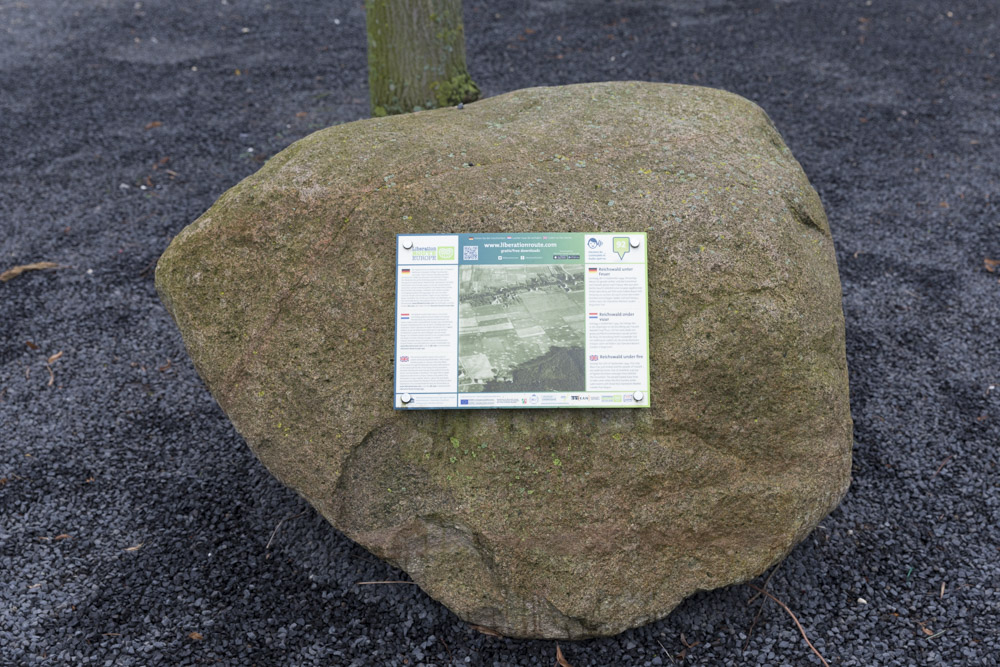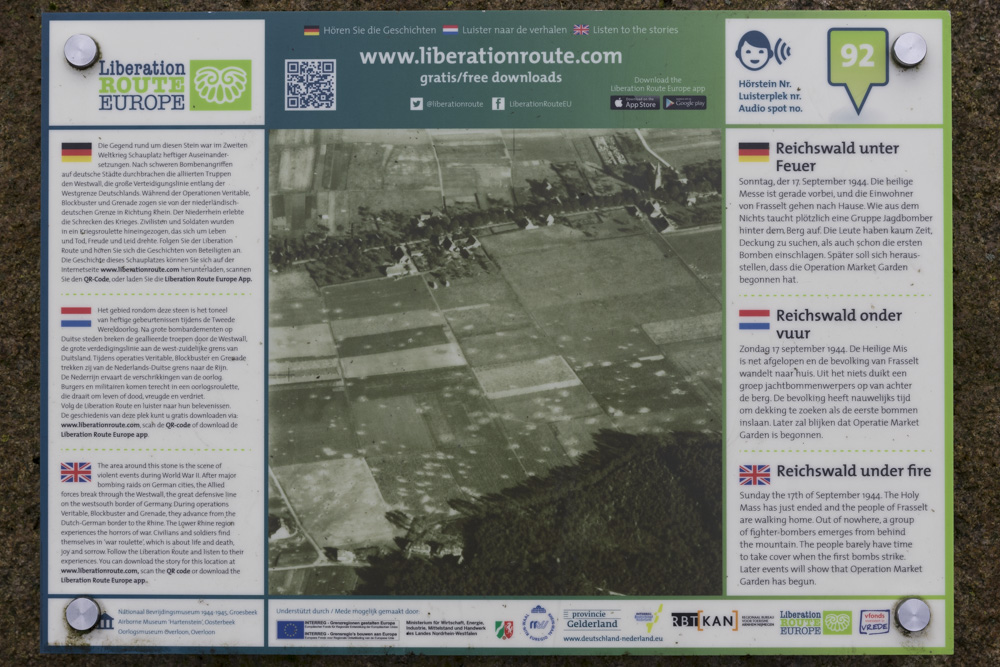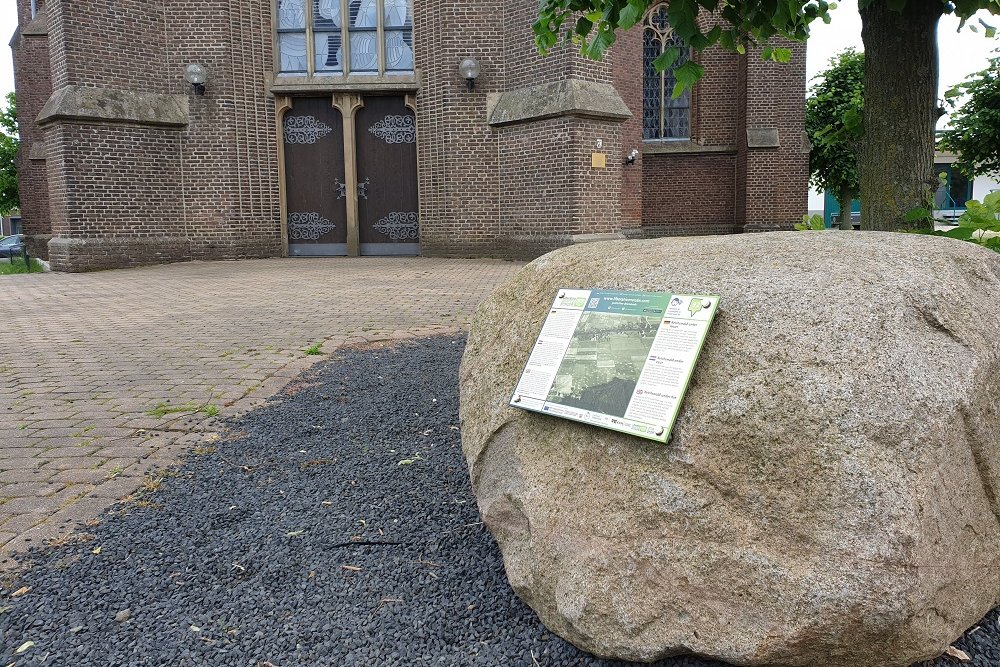Liberation Route Marker 092: Reichswald under fire
Reichswald under fire
Until September 1944, the citizens of Frasselt had been largely unaffected by the war. In preparation for Operation Market Garden, Allied bombers dropped large numbers of fragmentation bombs around the edge of the Reichswald to prevent the German troopsfrom posing a threat to the airborne troops. As far as we know, only civilians were hit. The pastor of Frasselt documented his memoirs in 1947.
Until September 1944, the citizens of Frasselt had been largely unaffected by the war. That changed with the Allied invasion of Normandy on 6 June 1944. The war broke out again in western Europe. The Siegfried Line was reactivated and, on Hitler’s orders in the ‘Führererlass’ of 24 August, construction was resumed. To stop the Allied advance, a trench had to be dug along the border. To that end, the Germans mobilised men too old for the army, Reichsarbeitsdienst (Reich Labour Service) units, and the Hitler Youth, as well as forced labourers. On 4 September, the digging began between the Rhine and the Reichswald.
5 September 1944 went down in history as Dolle Dinsdag (Mad Tuesday).
After the Allies took Antwerp, the Dutch collaborators, NSB members and some of the German troops panicked. They fled towards Germany en masse, reaching the area around Kleve. The Allies deployed fighter-bombers to prevent the German troops from falling back and reorganising. The strikes targeted military and strategic targets as well as retreating troops. The Allies had the upper hand in the skies; the German Flak anti-aircraft guns proved insufficient, and the attacks met with little resistance. The air raid siren had become a normal part of everyday life by this point.
As such, the air raid siren in Frasselt on the night of 16 to 17 September was not out of the ordinary. The only effect was that the church services—17 September was a Sunday—were not allowed to begin before 10:00. In his annals published in 1947, Father Wilhelm Kück talks about the events in Frasselt shortly after the end of the service. To ensure that German military troops, thought to be dug in around the outskirts of the Reichswald, would not pose a threat to the airborne troops, the forest was bombed with fragmentation bombs. As far as we know, only civilians were hit. Kranenburg and the surrounding area were battlefields for months.
Audiospot - Reichswald under fire
Liberation Route Europe is a certified Cultural Route of the Council of Europe. With hundreds of sites and stories in nine European countries, the route links the main regions along the advance of the Allied Forces in 1943-1945.
The entire route consists of themed routes that can be travelled by by hiking, walking, cycling and car. These routes pass numerous historical and interesting sites and tell stories from a multitude of perspectives that were important in the final phase of World War II.
Many routes feature listening spots, offering the opportunity to listen to a historical story at a location. In addition, many ‘Vectors of Memory’ have been placed, indicating that the passer-by is on one of the Liberation Routes.
The routes can be found on the Liberation Route Europe website or in the app through which many stories can also be listened to.
Do you have more information about this location? Inform us!
Source
- Text: TracesOfWar & Liberation Route Europe
- Photos: Arjan Vrieze (1, 2), Peter Schipper (3)
Nearby
Museum
Point of interest
- Information Sign Bombing 07-02-1945 Kleve - Kleve (Donsbrüggen)
- Evacuation of Breedeweg Groesbeek - Groesbeek
- Location Knickebein Radar Kleve - Kleve
Monument
- War Memorial Frasselt - Frasselt
- War Memorial Schottheide - Schottheide
- War Memorial Cemetery Kranenburg - Kranenburg
Cemetery
- German War Grave Kranenburg - Kranenburg
- Commonwealth War Cemetery Reichswald Forest - Kleve
- German War Cemetery Kleve-Dönsbrügger Heide - Kleve (Donsbrüggen)
Remembrance Stone
- Stumbling Stone Nijmeegseweg 34 - Gennep
- Stumbling Stones Markt 15 - Gennep
- Stumbling Stones Houtstraat 4-6 - Gennep
Fortification
- Trenches on Pyramid Hill - Milsbeek
- River Bunker South Maas-line Oeffelt - Oeffelt
- River Bunker North Maas-line Oeffelt - Oeffelt







